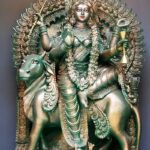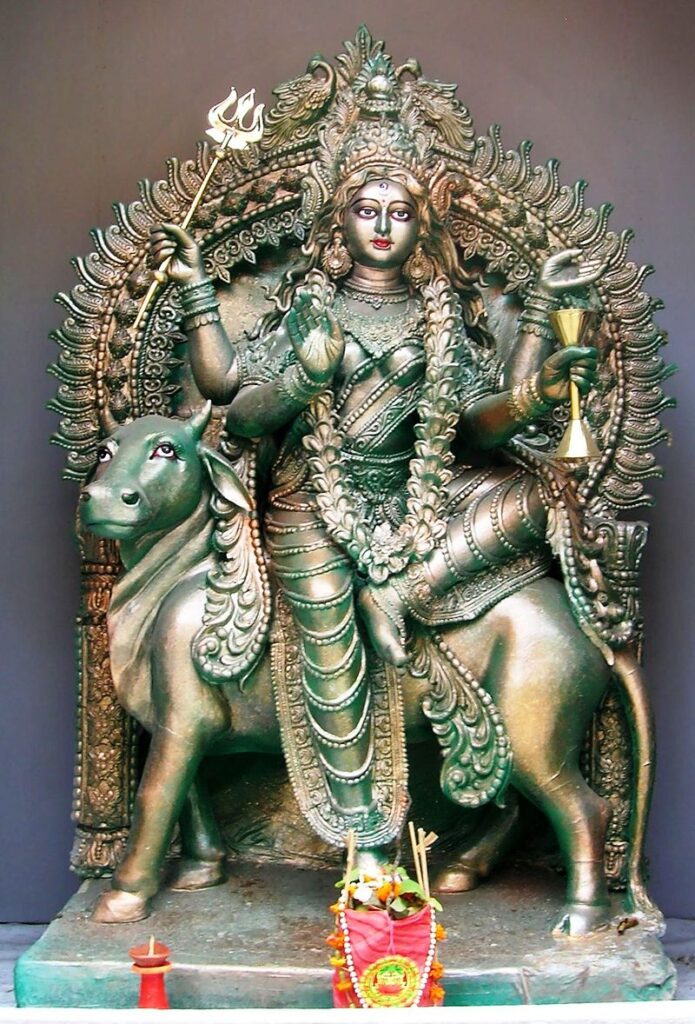
Mahāgaurī is the beautiful manifestation of Goddess Durga in her eighth form. She is worshiped on the eighth day of Navratri, more commonly known as Ashtami. Being a symbol of purity, serenity and tranquillity, Mahāgaurī is said to put an end to all the suffering of her devotees. It is also believed that Mahāgaurī is the 16 year old unmarried form of Goddess Parvati.

The name Mahāgaurī means extremely white, as she was white in color and very beautiful (Mahā, महा = great; Gaurī, गौरी = white). She is depicted as a three-eyed and four-armed beautiful Goddess mounted on a white Vrishabha (bull). Two of her arms on either side are in the Varada and Abhay mudras (poses) to bless and alleviate fears from the lives of her devotees, while her other two arms hold a trishul (trident) and damru (tambourine). On this day, the goddess is dressed in peacock green clothes and is adorned with white ornaments. Because of her fair complexion, Goddess Mahāgaurī is often compared with the moon, a conch and jasmine flowers.
She is auspicious, brilliant and protects the good people while punishing those who perform evil deeds. Mother Gauri enlightens the spiritual seeker and removes the fear of rebirth by granting salvation.
On the Path to Perfect Attainment, recall that the seventh Goddess, Kalaratri Devi, slays our ego, opening up space for the Divine Light. Ushering in this Divine Light is the role of the most radiant Goddess, Mahāgaurī , who resides in the crown (sahasrara) chakra.
Durga had taken on the form of Kali to kill the asuras Raktabija, Chanda and Munda. Later she returned to her form as Parvati but her skin was still as black as night. Brahma advised her to immerse herself in the lake known as Manasarovara. When she came out she was as radiant as the moon. This form of Parvati is known as Mahāgaurī . “Gauri” means “fair” and “maha” means “great.” Mahāgaurī is the ultimate light. We can scarcely imagine such brilliance. She is also known as Kaushiki.
She is very fair with three eyes brimming with compassion. She wears white clothes and delicate jewellery. She has four hands, two of which carry the trident and mini drum. The other two hands are raised in the “abhaya mudra” and the “varada mudra,” giving protection and boons to her devotees. Her vehicle is a pure white bull. We can appreciate her fully only after worshipping her form as Kalaratri!
Her favourite colour is purple and favourite flower is the mogra – jasmine. Her planet is Rahu. She is the symbol of intelligence and peace
She portrays the devoted wife, homemaker and nurturing mother who is the very foundation of a family. Goddess Mahāgaurī is known to be very forgiving. She easily forgives sinners and purifies them. She is the goddess who denotes peace and endurance. It is said that by worshiping her the devotee’s heart will become pure.
Her shloka is,
“Swete vrishe samaarudha, svetambara dhara, shuchihi,
Mahagauri shubham dadhyath, Mahadeva pramodada.”
“May that pure goddess, dressed in white and riding a white bull, who is the delight of Mahadeva, grant us all auspiciousness.”
In the third stage, Durga takes on the incarnation of Maha Saraswati and destroys the demons Raktabija, Shumbha, and Nishumbha. During the last three days we beseech Sarasvati to enter our hearts and fulfil the goal of human life which is to attain the Absolute. In that garden of our mind which has been weeded of all its negativity by the forceful Kaali, and in which the gracious Lakshmi has sown the seeds of positivity, we invite Saraswati, the one who can give us the bliss of union with the Absolute. Only in such a garden can the pure lotus of enlightenment bloom.